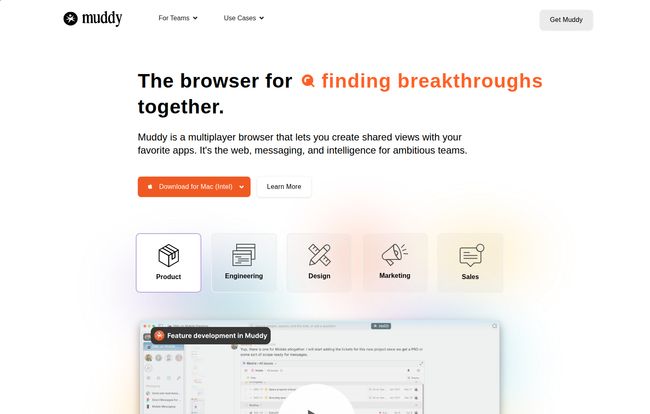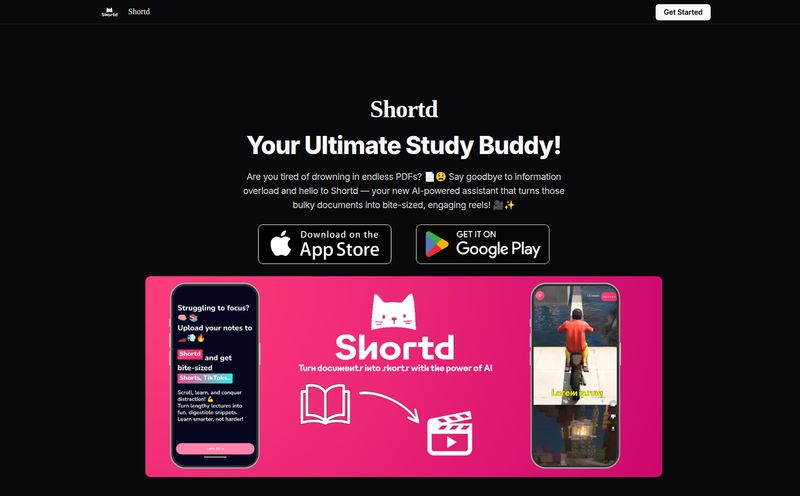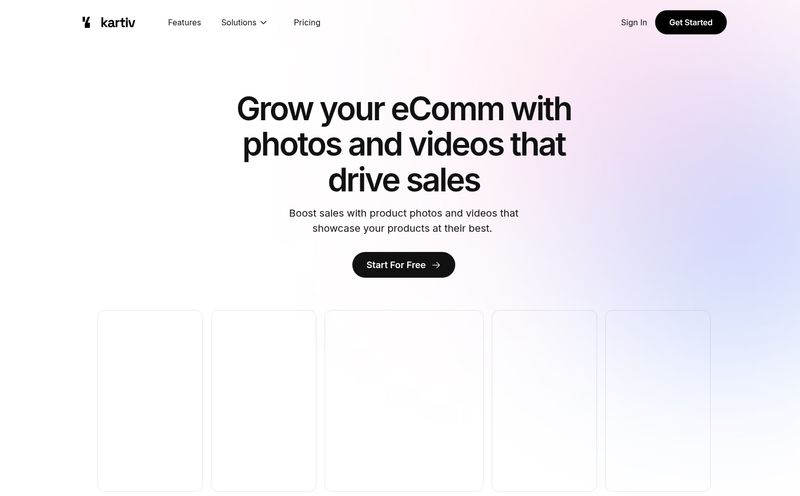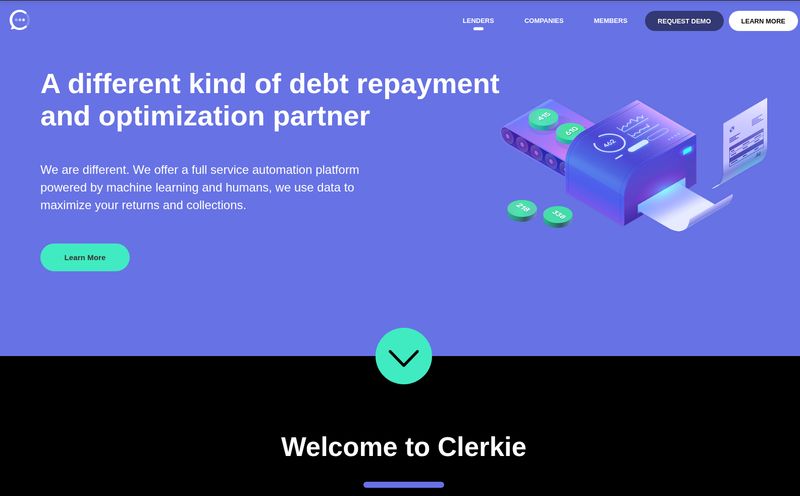How many tabs do you have open right now? Go on, I'll wait. If you’re anything like me, it’s a chaotic mix of Google Docs, Asana boards, Slack channels, Figma mockups, and at least three different articles you swear you're going to read later. Our digital workspaces are a mess. We’re constantly context-switching, losing threads, and wasting precious brainpower just trying to find stuff.
Every so often, a tool comes along that claims to be the silver bullet. The one platform to rule them all. Most of the time, I roll my eyes. It’s usually just another app to add to the pile. But then I stumbled upon Muddy. Their pitch? A “multiplayer browser for ambitious teams.”
A multiplayer… browser? My curiosity was piqued. It sounds like something out of a sci-fi novel, but the problem it aims to solve is painfully real. So I put on my professional skeptic hat (it’s a well-worn hat, trust me) and decided to see if Muddy is just more marketing fluff or if it’s genuinely onto something big.
So What Exactly Is This "Multiplayer Browser" Anyway?
Forget what you know about Chrome, Safari, or Firefox for a second. They were built for one person to browse a public internet. Muddy is built from a different philosophy entirely. It’s designed for a team to work on the internet, together.
Think of it like this: your standard browser is a solo kayak. It gets you where you need to go, but you're on your own. Muddy is more like a team’s rowing shell. Everyone is in the same boat, seeing the same course, and pulling in the same direction. It’s a shared, persistent space that holds all your apps, files and communications. Instead of each team member having their own chaotic collection of 50 tabs, the team has one organized, shared workspace for a project. Now that’s an interesting idea.
The Standout Features That Genuinely Caught My Eye
A cool concept is one thing, but execution is everything. Muddy has a few core features that form the backbone of its collaborative experience. Some are clever, and one, in particular, feels a bit like magic.
The Shared Workspace: Your Team's Digital HQ
This is the foundation. Muddy lets you create dedicated “workspaces” for different projects. Inside a workspace, you can pull in any web app—your Trello board, a Google Sheet, a customer support dashboard, whatever. The whole team sees the same view, organized on a timeline. No more sending links back and forth on Slack with the classic, “Hey, can you look at this?” Now, it’s just… there. For everyone. It’s a subtle shift, but it creates a powerful sense of shared context.
Infinite Rewind: A Time Machine for Your Projects
Alright, this is the one. This is the feature that made me sit up and say, “whoa.” Muddy records the state of your workspace over time. With its “Infinite Rewind,” you can literally drag a timeline slider back to see what the project looked like yesterday, last Tuesday, or at the exact moment a key decision was made.
Imagine a new team member joining a project mid-way. Instead of a two-hour-long briefing where you try to piece together history from old emails and meeting notes, you can just say, “Rewind the workspace and watch the last two weeks unfold.” It's a game-changer for project archeology and onboarding. It’s the closest thing I’ve seen to a project’s very own DVR.

Visit Muddy
Universal Commenting: Finally, an End to Silos
Here’s a familiar pain point: you want to leave feedback on a specific part of a webpage or a third-party app, but there's nowhere to type. So you take a screenshot, upload it to Slack, draw a wobbly red circle on it, and type out your comment. It's clunky. Muddy fixes this with universal commenting. You can drop a comment pin on any element, on any app or website, and tag your teammates. The comments live within Muddy, layered on top of your apps. It keeps conversations tied directly to the work, right where they belong.
AI That Actually Seems to Help
"AI-powered" is the buzzword of the decade, and frankly, I'm getting tired of it. But Muddy’s use of it feels practical. The AI helps automatically organize your tabs and workspaces based on context. It learns how your team works and starts to intelligently group related items. The goal is to spend less time managing your browser and more time doing the actual work. A noble goal, and from what I've seen, it does a decent job of taming the digital chaos.
A Real-World Look at How Muddy Changes the Game
Let's picture a product team launching a new feature. Normally, the designer is in Figma, the PM is in Jira, the engineer is in GitHub, and the marketing lead is in a Google Doc. Everyone is working on the same project, but in four different digital rooms.
With Muddy, they're all in one shared workspace. The PM can see the live Figma designs update. The designer can click over to the Jira ticket to see the technical requirements. Anyone can use universal commenting to drop a question directly on the staging environment. And when the CEO asks, “Why did we choose this shade of blue?”, the PM can just rewind the timeline to the conversation where the design was approved. It connects the dots in a way that feels incredibly natural.
The Good, The Bad, and The Muddy
No tool is perfect, and as an SEO and traffic guy, I've learned to be wary of shiny objects. Here's my balanced, no-nonsense breakdown.
What I Genuinely Liked
The sense of a shared reality is the biggest win. It reduces the friction of collaboration. That feeling of “everyone is literally on the same page” is powerful. The Infinite Rewind feature is not a gimmick; it’s a genuinely innovative solution to a real business problem—preserving institutional knowledge. And I have to admit, seeing your teammate's cursor moving around in an app that isn't a Google Doc is pretty cool. It fosters a sense of presence, especially for remote teams.
Where I Would Pump the Brakes
Let's be real, there will be a learning curve. This isn’t just a new browser; it's a new way of working. Getting a whole team to change their habits is a huge ask. There's also the risk of platform dependency. If your entire workflow becomes embedded in Muddy, it can feel a bit like a walled garden. And while I didn't experience major issues, any app that aims to hold all your other apps is going to be resource-intensive. I can see it struggling on older machines or for users who are true tab hoarders. It's something to keep an eye on.
So, What's the Damage? Muddy's Pricing
This is often the million-dollar question. Interestingly, the main Muddy website doesn't list clear pricing tiers, which is pretty common for a product that's new or still finding its enterprise footing. However, the FAQ section on their page gives us the answer: they use a freemium model. There’s a free version that is powerful for individuals, and then paid plans for teams that unlock the full multiplayer collaboration features. This is a smart approach. It lets you or a small part of your team try it out and prove its value before going all-in.
Is Muddy Trying to Replace Chrome?
Yes and no. The FAQ says you can use it as your default browser, and it even supports your existing Chrome extensions, which is a massive plus. But I don't think it's competing with Chrome on Chrome's terms. Chrome is a utility for accessing the internet. Muddy is a specialized environment for working on the internet.
It’s part of a growing trend of browsers like Arc and SigmaOS that are rethinking what a browser should be. They're not just trying to be faster or use less memory; they're trying to fundamentally change your relationship with the web. Muddy’s unique angle is its laser focus on the team.
My Final Verdict: Is Muddy Worth the Switch?
After spending some real time with it, I'm cautiously optimistic. Muddy isn't just another productivity app. It's a thoughtful attempt to fix the fragmented, chaotic nature of modern digital work. It won't be for everyone. If you're a solo freelancer perfectly happy with your current setup, it might be overkill. But for a growing startup, a creative agency, or any tight-knit team that lives in web apps, I think Muddy could be transformative.
It's one of the few tools I've seen that doesn't just add another layer, but tries to build a better foundation. It’s ambitious, clever, and if they can get teams to overcome the initial learning curve, it just might be a glimpse into the future of collaborative work.
Frequently Asked Questions About Muddy
- Can I use Muddy by myself, or is it only for teams?
- You absolutely can. According to their site, the AI organization and workspace features make it a powerful browser for individuals, too. The team features are what you get when you upgrade to a paid plan.
- Does Muddy completely replace Google Chrome?
- It can function as your primary, default browser. Since it supports Chrome extensions, the transition is smoother than you might think. However, its real strength is as a dedicated work browser, separating your professional life from your personal browsing.
- How does it handle my existing Chrome extensions?
- Muddy is built on Chromium, the same open-source project as Google Chrome. This means your favorite extensions should work right out of the box, which is a huge relief for anyone who relies on their password manager or SEO tools.
- What's the main benefit of the "Infinite Rewind" feature?
- It's all about context and history. It allows you to see the entire evolution of a project, making it perfect for reviewing past decisions, understanding how a project got to its current state, and quickly onboarding new team members without lengthy handover documents.
- Is Muddy secure enough for sensitive company data?
- As a tool designed for business, security is obviously a priority. While you should always review the specific privacy policy of any new tool, Muddy operates as a browser layer and doesn't host your app data itself (your data remains in Google Docs, Figma, etc.). However, for any business-critical implementation, a direct review of their security protocols is always recommended.
Reference and Sources
- Muddy Official Website
- The Verge - The file system is dead for Gen Z (Context on changing digital organization habits)



